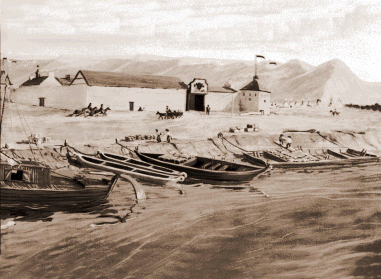 |
The site of historic Fort Benton is of
national significance and deserving of
all possible efforts to protect it.
However, the site has undergone many
dramatic changes that have affected its
integrity since the Fort was abandoned
in 1881 . Sun dried adobe bricks were
not able to stand up to the ravages of
Montana's weather and by the 1940's only
the preserved north- east bastion and a
partial wall from the Engages' Quarters
remained. Trees were planted throughout
the site and it was transformed into a
part of the city park. Ever since the
Fort was abandoned the site has
experienced continuing erosion including
the construction of an asphalt road
through the site, and sewer lines, power
lines, and an underground sprinkler
system were brought through the site.
Each year an unknown number of artifacts
were removed by souvenir hunters.
It was evident the site had to be
protected or, in the not too distant
future, there would be nothing remaining
from the last of the trading posts on
the Upper Missouri River. |
A number of
methods to preserve the cultural resource of the
Fort were examined. It has been determined
that the most effective method will be to
reconstruct the Fort over the site thereby
encapsulating the resource forever and preventing
further degradation and erosion.
SCOPE
OF THE PROJECT
Historic Fort Benton is being
reconstructed as historically accurate as possible,
based on the results of the archaeological
excavations and extensive research.
| Included in the Reconstruction Plan: |
The 29, 946 square
foot Compound
The Trade Store (1,500 square feet)
The Warehouse(1,625 square feet on each
floor)
The Blacksmith - Carpenters Shop (875
square feet)
The NW Blockhouse (400 square feet on
each floor)
The Engagees' Quarters (2,250 square
feet on each floor)
The Bourgeois Quarters (2,250 square
feet on each floor)
The SW Blockhouse (400 square feet on
each floor)
The Kitchen (875 square feet on each
floor)
The Barn (1,400 square feet) |
PROJECT PROGRESS
The Trade Store, the
Warehouse, the Blacksmith and Carpenter's Shop, the
"Sally Port" Gate, the Compound walls, and the
Agents Quarters/Bourgeois House, which is home to
the renowned Starr Gallery of Western Art have been
reconstructed.
Negotiations with the
Blackfeet Nation, seeking their involvement in
interpreting the fur and robe trade, have taken
place. Elders from the Blood or Kainai tribe, the
Siksika, the Northern Piegan or Piikani, and the
Southern Piegan or Pikuni tibes have spent many
hours, recording their oral history and remembrances
of Fort Benton, as the first step in developing the
Blackfeet Nation's interpretation. The
Restoration Committee and representatives appointed
by the Blackfeet Tribal Council have developed and
implemented an interpretive plan which may now be
viewed in the Warehouse interpretive area.
The Fort, is operated by the
River & Plains Society, as a part of their Heritage
Complex and Museums is now open to the public daily, from
the end of May through
the end of September.
|